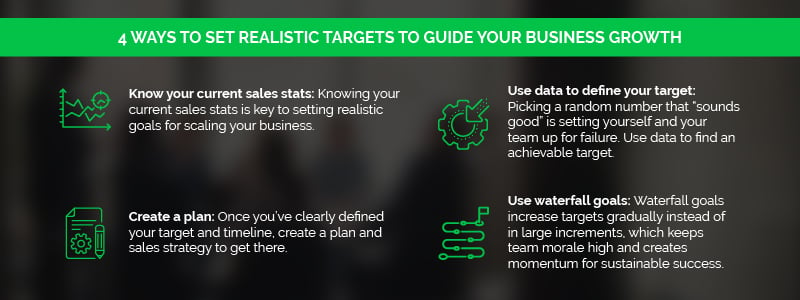4 Steps to Set Realistic Business Goals That Will Guide Your Growth

Setting realistic sales targets is the ideal way to guide your business growth. Here’s how to set smart sales goals that will sustainably scale your business.

As a business owner, it’s important to set goals in order to grow. Unfortunately, only 5% of small businesses meet all their yearly goals despite 77% of business owners having confidence in executing their business plans. These numbers suggest that business owners are overconfident in their ability to meet goals, as 95% fail to meet all of their objectives.
While this may just sound like aggressive goal-setting, unsustainable goals ultimately undercut morale and growth. It’s important to set targets you and your team can achieve and sustain to ensure long-term growth.
Keep reading to learn how to set realistic targets to guide your growth and scale your business.
1. Know your current sales stats
Establishing your baseline is crucial to growth. In fact, there’s no way to accurately plan for, or measure for, growth without knowing where you started and where you are currently. You should already have an established minimum sales target that’s needed to generate revenue. How long did it take to get to where you are now? What’s your average annual growth as it stands right now? What is the current close rate of your sales team for the past 12 months?
Sales are the lifeblood of your business. Keep a finger on the pulse of the sales pipeline to identify where growth might be found.
2. Use data to define your target
Every entrepreneur should be intimately familiar with the numbers that drive their business. Your sales goals should be driven by that data. It’s okay to have an aspirational long-term goal that feels good for you, but setting sales goals that don’t match your data is setting your team up for failure. When your team fails, so will your business, so use the data you have available to craft realistic growth goals.
To find a realistic target, first calculate your average close rate for the last 12 months. This is how many deals were closed versus leads. Example: Out of 600 leads, if your team closed 12 sales, your close rate is 2%. Next, forecast what your team should be hitting to maintain the baseline minimum. Let’s say the baseline minimum to generate revenue would be 16 sales per month. With a close rate of 2%, you’d need 800 leads per month to make 16 sales. That’s to hit your baseline, so in order to grow, you’ll need to add to that.
3. Create a plan
As the saying goes, “If you fail to plan, you plan to fail.” Once you’ve used data to define growth targets, you can start engaging your creativity and business acumen.
What needs to happen for you to hit these numbers? How will you incentivize your team: Individually or collectively? Will you introduce new products or change your marketing strategies for existing products?
Your plan should include mapping out the actionable steps that must be taken, who will be responsible for what, how you will monitor the process and objectives, and prioritizing accordingly. Creating a plan will also give your sales team a blueprint to follow. Sales quotas are a benchmark for your team. Setting realistic, accurate, and achievable quotas builds momentum and boosts morale, which is great for your bottom line.
Monitor this plan regularly and be prepared to adapt it as needed.
4. Use waterfall goals
Waterfall goals build progress in a linear fashion at a smaller scale. This allows your team to build confidence and momentum as they work towards larger goals.
In the previous example, the team needed to go from 600 to 850 leads per month to generate revenue. Let’s say their new goal for growth is now 1000 leads per month. Jumping from 600 to 1000 leads per month would be a 40% increase, which is a lot to ask. A waterfall goal would be to increase leads by 100 per month until the goal is reached. This avoids the panic and burnout of tasking your team with an unattainable quota all at once.
It’s also important to share and celebrate the results of the team’s hard work with them. By setting waterfall goals, your team will have a new record to celebrate together every month!
While the market and how we do business are constantly changing, some things will never change. One constant is that, in order to grow, your business needs realistic sales targets. By establishing a baseline, basing your goals on data, creating a plan, and setting waterfall goals, you can set your team up for success.
MetaGrowth helps business owners ditch the daily grind of “founder selling” by building an amazing team of dedicated sales professionals to do your selling for you. Co-founders Josh Hirsch and Joe Arioto will put their combined 30,000 hours of coaching and consulting expertise to work for you on solutions-based sales consulting that will help you free up time to focus on what really matters: Your growth strategy.
If you want to build your very own world-class sales team without investing a ton of time — not to mention headaches or hassles — contact us today. We’ll help you build a dream team to start boosting your sales in no time!
Written by
Josh Hirsch
